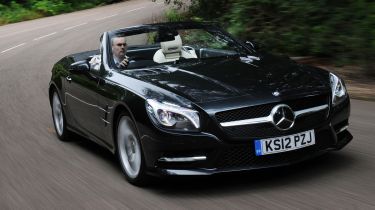Mercedes SL350
We drive the entry-level, V6-engined Mercedes SL350 on UK roads for the first time

At this end of the market, many buyers will be tempted to spend the extra £11,000 on the Mercedes SL500. But they should think twice. The SL350 is better value for money, cheaper to run and more fun through corners, so it appeals equally to the head and the heart. Although it doesn’t have the effortless punch of the turbocharged V8 model, this car is definitely the pick of the new SL range.
Go for the Mercedes SL350 rather than the SL500, and you’ll save just under £11,000. But as the only difference between the two is the engine, the SL350 could be a bargain – if you can call £72,495 a bargain.
While the SL500 has a 429bhp 4.4-litre twin-turbo V8, the SL350 is powered by a 3.5-litre V6 with 302bhp, so you sacrifice a bit of performance. Officially, the 350 covers 0-62mph in 5.9 seconds – the 500 does it in 4.6 seconds – but it feels punchy and instantly responsive. In fact, it’s all the pace you’ll ever need on the road.
The SL350 also feels more like a sports car, encouraging you to use the whole rev range, rather than the effortless and almost lazy low-rev punch of the SL500’s engine. Take a look at the figures and it’s easy to see why. The V8 delivers 700Nm of torque from 1,800rpm, while the SL350 has just 370Nm from 3,500rpm. And although the V6 doesn’t offer the V8’s menacing roar, it still makes a nice, understated growl.
Used - available now

2022 Fiat
500
22,532 milesManualPetrol1.0L
Cash £9,549
2023 Honda
Jazz
24,192 milesAutomaticPetrol1.5L
Cash £14,999
2022 Vauxhall
Corsa
30,379 milesManualPetrol1.2L
Cash £11,549
2022 MINI
5-Door Hatch
32,498 milesAutomaticPetrol1.5L
Cash £15,049There are also a few subtle differences in the way this car handles. While the quick steering in the SL500 always seems to be offset a little by the car’s sheer weight, the SL350 – which is 100kg lighter – feels eager to dart into bends with real agility.
Just bear in mind that all SLs are short on steering feel, so you won’t find the same level of driver involvement in any model that you’ll get in a Porsche 911.
In every other way, though, this cheaper SL feels identical to more expensive models in the range, so that means a luxurious ride and excellent refinement.
Our car featured adaptive dampers, and with them set to Comfort, the SL made short work of a 200-mile motorway journey. It glides along rough roads and only reveals a hint of firmness when driving over deep ruts.
With the roof up – a process that takes around 16 seconds – it’s easy to forget that you’re in a convertible. Usually, there are a few squeaks and rattles along with a bit of wind noise, but the SL can happily cruise at 70mph with barely any sound piercing the peace and quiet inside.
The cabin feels luxurious, with leather covering the dashboard, seats and central armrest. Almost everything else is finished in brushed metal or wood, which makes the car seem worth every penny of its eye-watering price.
And you can also add lower running costs to the SL350’s list of talents. It’s 140kg lighter than the car it replaces, which helps it return 37.7mpg and emit 169g/km of CO2. In comparison, the SL500 claims 30.7mpg and 212g/km. Both models are equipped with stop-start, but the system works more seamlessly in the V6, cutting the engine smoothly and firing it up again almost instantly.
The SL350 scores with its sharper handling and more frantic V6. So if you’re in the market for a new SL, we’d say cheaper is definitely better. As long as you can put up with the slower 0-62mph time, the SL350 has plenty of benefits over its muscular, V8-engined brother.







